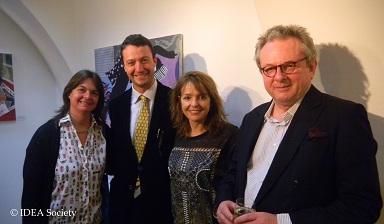| Vernissage: Lea Fuchs - 7.11.2014 |
|
Alexandra Ungern-Sternberg, Stefan Stoev, Lea Fuchs, Alessandro Pallavicini Lea Fuchs: Looking into the Johari Window, by Dr. Renée Gadsden The question isn’t who’s going to let me; it’s who is going to stop me. – Ayn Rand By painting archetypal forms and enigmatic figures, Lea Fuchs explores social factors and gender constructions as a major aspect of the human condition. Her specialty is rendering familiar objects in combination with the human body. Perhaps her most abiding interest is the human form and all it represents, specifically as manifested by the female body. Not only does she look at, question and shed light on all aspects of female subjectivity in her paintings and illustrations, Fuchs takes care to execute the figures that she creates so that their origins are not too distinct. In this simple and direct way she maintains the tension between abstract and figural depiction. Fuchs says that her main topics are “the interior, the still life and the human body”. One framework for her to explore these subjects is the window, fereastra in Romanian, a word she finds to be particularly beautiful. For Fuchs, a window represents the possibility of looking into secret worlds. She compares a painting to a window into another universe and asks: what does a window reveal to me? Is it only that I look out of the window? Or does the outer world look in through the window at me? A window gives structure: it is something solid, it can define things. Fuchs emphasizes that structure is something she needs, because without structure she would run riot (ausschweifen). Therefore she tends to set frameworks and proceed in a very structured way. She asks herself each time she approaches the canvas: where are the main axes, where is my space? In this vein Fuchs explains why she shies away from pure abstraction. A classical composition, such as her predecessors Georges Braque or Pierre Bonnard investigated, is extremely important to her. Yet she does not bind herself only to levels of representation and composition. Lea Fuchs loves color! Through color she controls and directs the mood, the atmosphere. Fuchs is attracted to blues and greens, to “cold” colors. Laughingly she says, “The colder, the better!” Madame Fuchs is a polymath, a Renaissance woman. In Sir Galahad’s words, she is both “Mutter und Amazon” (mother and Amazon). Fuchs is as comfortable assessing a profit curve as she is mixing colors on her palette. Fulltime artist, fulltime businesswoman, fulltime mother, fulltime family co-head and fulltime friend: Lea Fuchs demonstrates to us that art is the art of life. We are grateful that she perpetuates the myth of the superwoman by quietly upholding the dignity of woman, “the nigger of the world”, as described by Yoko Ono and set to music by John Lennon. Her serene canvases breathe the domestic wit and esprit of René Magritte, combined with the cry of the anguished soul that Giorgio di Chirico so poignantly was able to capture. Lea Fuchs is a proud follower of this approach to art. Still, she simultaneously redefines the medium and the message as her own. The Johari window of Lea Fuchs is her artwork, which sheds light on all facets of the condition humaine. Her visual world opens the windows of perception of the 21st century person. Joyfully, these windows exist for both her and her viewers alike. © Text: Renée Gadsden, 2014 |





